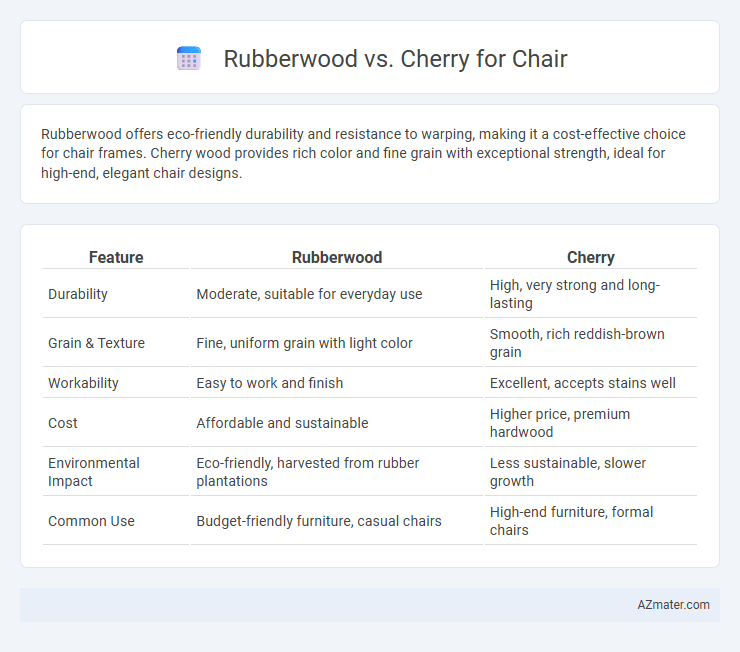Rubberwood offers eco-friendly durability and resistance to warping, making it a cost-effective choice for chair frames. Cherry wood provides rich color and fine grain with exceptional strength, ideal for high-end, elegant chair designs.
Table of Comparison
| Feature | Rubberwood | Cherry |
|---|---|---|
| Durability | Moderate, suitable for everyday use | High, very strong and long-lasting |
| Grain & Texture | Fine, uniform grain with light color | Smooth, rich reddish-brown grain |
| Workability | Easy to work and finish | Excellent, accepts stains well |
| Cost | Affordable and sustainable | Higher price, premium hardwood |
| Environmental Impact | Eco-friendly, harvested from rubber plantations | Less sustainable, slower growth |
| Common Use | Budget-friendly furniture, casual chairs | High-end furniture, formal chairs |
Introduction to Rubberwood and Cherry for Chairs
Rubberwood is a sustainable hardwood derived from rubber trees, known for its strength, light color, and affordability, making it a popular choice for chair manufacturing. Cherry wood offers a rich, reddish-brown hue with a fine, smooth grain and is prized for its durability and elegant appearance in high-end furniture, including chairs. Both woods provide distinct aesthetic and functional qualities, influencing their use based on design preferences and budget considerations for chairs.
Overview of Rubberwood Characteristics
Rubberwood is a sustainable hardwood known for its light color, fine grain, and smooth texture, making it ideal for chair manufacturing. It offers good durability and resistance to warping, with moderate hardness that balances comfort and sturdiness. The wood's eco-friendly nature stems from repurposing plantation trees after latex collection, contributing to environmental conservation.
Key Features of Cherry Wood
Cherry wood is prized for its rich, reddish-brown color that deepens with age, providing a warm, elegant appearance ideal for chair craftsmanship. It boasts a fine, straight grain and smooth texture, ensuring durability and comfortable seating surfaces. Cherry wood's natural resistance to warping and its moderate hardness make it a long-lasting choice for chairs that combine both strength and aesthetic appeal.
Durability Comparison: Rubberwood vs Cherry
Rubberwood offers moderate durability with good resistance to wear and insect damage, making it a cost-effective choice for chair construction. Cherry wood excels in durability due to its dense hardwood structure, providing superior strength and resistance to dents and scratches over time. For long-lasting chairs, cherry is generally preferred for its enhanced structural integrity and aging characteristics.
Aesthetic Differences: Color and Grain
Rubberwood features a pale, yellowish tone with a fine, straight grain that offers a clean, contemporary look ideal for modern chair designs. Cherry wood displays a warm, reddish-brown hue that deepens with age, accompanied by a smooth, wavy grain pattern, creating a rich, classic aesthetic. The contrast between Rubberwood's light, uniform surface and Cherry's vibrant, evolving color and textured grain makes each wood distinctly suited for different interior design styles.
Sustainability and Environmental Impact
Rubberwood, harvested from rubber trees at the end of their latex-producing cycle, is a highly sustainable option that utilizes timber otherwise discarded, reducing deforestation pressures and waste. Cherry wood, prized for its rich color and durability, comes from slower-growing hardwood trees, often leading to higher environmental impact due to longer harvest cycles and less availability. Choosing rubberwood chairs supports eco-friendly furniture production through renewable resource use and lower carbon footprint compared to cherry wood alternatives.
Cost Analysis: Rubberwood vs Cherry
Rubberwood offers a cost-effective alternative to cherry wood for chair manufacturing, with prices averaging significantly lower due to its abundance and faster growth cycle. Cherry wood commands a premium price driven by its rich color, fine grain, and high durability, making it more suitable for luxury or heirloom pieces. Choosing rubberwood reduces material expenses while maintaining sufficient strength and aesthetic appeal for budget-conscious furniture buyers.
Maintenance and Care Requirements
Rubberwood requires minimal maintenance with regular dusting and occasional application of furniture polish to keep its surface smooth and resistant to moisture. Cherry wood demands more attentive care, including protection from direct sunlight to prevent color fading and periodic treatment with wood oils to maintain its rich, reddish-brown patina. Both materials benefit from avoiding excessive moisture exposure to prolong the chair's durability and appearance.
Suitability for Chair Construction
Rubberwood offers excellent durability and resistance to wear, making it highly suitable for chair construction where strength and longevity are essential. Cherry wood provides a rich, attractive finish with moderate hardness, ideal for elegant chairs but less resistant to heavy use compared to rubberwood. Both woods are workable, but rubberwood's cost-effectiveness and stability under varying conditions make it a preferred choice for robust, everyday chairs.
Final Verdict: Choosing Between Rubberwood and Cherry for Chairs
Rubberwood offers an eco-friendly, affordable option with good durability and a light, uniform grain, making it suitable for casual or budget-conscious chair designs. Cherry provides a rich, warm color and superior strength, ideal for elegant or heirloom-quality furniture requiring long-lasting appeal. The final choice depends on budget, aesthetic preference, and desired longevity, with cherry favored for premium craftsmanship and rubberwood for cost-effective sustainability.

Infographic: Rubberwood vs Cherry for Chair
 azmater.com
azmater.com